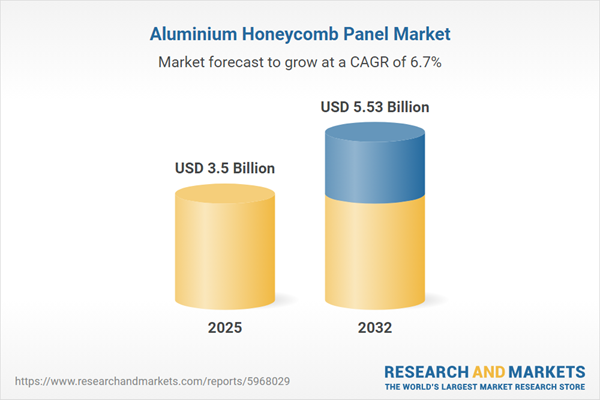Speak directly to the analyst to clarify any post sales queries you may have.
The aluminium honeycomb panel market is evolving into a cornerstone solution for high-performance, lightweight structural components, with adoption expanding rapidly across multiple industries. Stakeholders now require deep insights into trade impacts, technological advancements, and segment-level opportunities to drive strategic growth in this dynamic market.
Market Snapshot: Aluminium Honeycomb Panel Market Size and Growth
The aluminium honeycomb panel market grew from USD 3.29 billion in 2024 to USD 3.50 billion in 2025. It is projected to maintain a compound annual growth rate (CAGR) of 6.69%, reaching USD 5.53 billion by 2032. This robust expansion is driven by the material’s unique blend of lightweight durability and structural integrity, meeting evolving requirements within aerospace, automotive, marine, construction, and industrial applications.
Scope & Segmentation: Strategic Landscape of the Aluminium Honeycomb Panel Market
This comprehensive market research report delves into a structured analysis across the sector’s key segments, technologies, and regions.
- Product Types: Bare panels; coated variants (including polyester, polyvinylidene fluoride, powder-coated); corrugated; perforated.
- Form Factors: Curved panels for aerodynamic applications; flat panels for modular assembly.
- Panel Thickness: Options include panels measuring 10–30 mm, less than 10 mm, and more than 30 mm.
- Manufacturing Process: Adhesive bonding, foil expansion, high-temperature bonding.
- Applications: Advertising boards, ceilings, clean rooms and laboratories, elevator wall panels, exterior wall cladding, flooring and raised access floors, interior decoration.
- End-Use Industries: Aerospace (commercial, defense, spacecraft), automotive (commercial and passenger vehicles), building and construction (exterior facades, interior), energy, industrial manufacturing, marine (commercial ships and yachts).
- Distribution Channels: Offline and online channels support diverse customer procurement needs.
- Regions: Americas (North America, Latin America), Europe, Middle East & Africa, Asia-Pacific.
Key Takeaways for Senior Decision-Makers
- The market benefits from cross-industry adoption, as industries such as aerospace, automotive, and construction pursue improved strength-to-weight performance and durability.
- Continuous advancements in core structure, surface treatments, and adhesive technologies support the development of specialized panels adapted to thermal, mechanical, and acoustic requirements.
- Regional manufacturing investments and supply chain localization initiatives mitigate cost volatility arising from trade shifts and support just-in-time delivery requirements.
- Sustainability imperatives, such as closed-loop recycling and reduced carbon footprints, are reshaping production processes and product credentials.
- Digital engineering, additive manufacturing, and sensor integration are redefining value, enabling enhanced product differentiation and facilitating data-driven maintenance offerings.
Tariff Impact: Navigating 2025 United States Trade Developments
Recent adjustments to United States tariffs on certain aluminium honeycomb panel imports have increased costs for international suppliers. This drives partial cost transfer to end-users and encourages a shift toward local and regional sourcing. Market participants are investing in domestic production, strategic partnerships, and free trade zone utilization to optimize supply chains and reduce procurement risk. Such policy changes continue to influence both competitive positioning and sourcing strategies across major end-use industries, prompting a strategic reevaluation of North American and international market entry approaches.
Methodology & Data Sources
Report findings leverage primary interviews with industry stakeholders including panel producers, adhesive and coating experts, application engineers, and regulatory authorities. Secondary research comprises reviews of technical literature, company publications, and industry white papers. Analytical tools such as PESTLE and Porter’s Five Forces contextualize macro-environmental and competitive factors. Expert peer review ensures quality and objectivity throughout.
Why This Report Matters to Industry Leadership
- Enables precise segmentation and opportunity mapping for innovation-led product development and market expansion.
- Guides risk management and procurement strategies through an in-depth analysis of regional, regulatory, and supply chain trends.
- Supports competitive differentiation via actionable intelligence on technology launches, sustainable manufacturing, and evolving customer requirements.
Conclusion: Strategic Outlook
Aluminium honeycomb panels will continue to play a pivotal role in next-generation structural applications. This report equips decision-makers to anticipate regulatory shifts, leverage emerging technologies, and build agile, resilient value chains in a rapidly advancing marketplace.
Additional Product Information:
- Purchase of this report includes 1 year online access with quarterly updates.
- This report can be updated on request. Please contact our Customer Experience team using the Ask a Question widget on our website.
Table of Contents
3. Executive Summary
4. Market Overview
7. Cumulative Impact of Artificial Intelligence 2025
Companies Mentioned
The companies profiled in this Aluminium Honeycomb Panel market report include:- 3A Composites GmbH
- Alucoil, SAU
- Argosy International Inc.
- Changzhou Evergreen Technology Co.,Ltd.
- ECOEARTH SOLUTIONS by Chemtreat India Limited
- EconCore N.V.
- Encocam Ltd.
- Flatiron Panel Products LLC.
- Henan Climb Aluminium Co., Ltd.
- Hexcel Corporation
- HONYLITE PRIVATE LIMITED
- Hunter Douglas
- Liming Honeycomb Composites Co., Ltd.
- Pacific Panels Inc
- Plascore, Inc.
- PT. Prima Xinbang Alumindo
- Samia Canada Inc.
- Shanghai Metal Corporation
- Toray TCAC Holding B.V
- UNIVERSAL METALTEK
- Aludecor Lamination Private Limited
- Guangzhou Green Energy International Building Materials Co., Ltd.
- JIANGSU HyGROW COMPOSITES CO.,LTD.
- RelCore Composites Inc.
- Schütz GmbH & Co. KGaA
Table Information
| Report Attribute | Details |
|---|---|
| No. of Pages | 185 |
| Published | November 2025 |
| Forecast Period | 2025 - 2032 |
| Estimated Market Value ( USD | $ 3.5 Billion |
| Forecasted Market Value ( USD | $ 5.53 Billion |
| Compound Annual Growth Rate | 6.6% |
| Regions Covered | Global |
| No. of Companies Mentioned | 26 |









